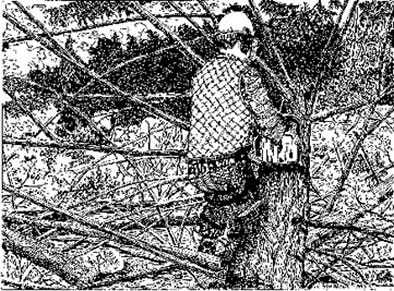Recommended Voluntary Forest Management Practices for New Hampshire
1.5 STAYING SAFE WORKING IN THE WOODS
BACKGROUND
If good safety practices aren't followed, working in the woods alone with chainsaws and other equipment can result in swift and serious injuries or death. Expensive equipment can be damaged or destroyed if operated in an unsafe manner.
 Loggers and others whose occupation is associated with tree cutting take courses on safety and are generally expected to conform to certain safety practices. Private landowners don't have similar requirements but are encouraged to attend chainsaw and other safety classes or orientations and hands-on training. A few basic practices can make the difference between a productive and exhilarating (even if tiring) session in the woods and possible serious personal injury, damage to equipment, or damage to residual trees.
Loggers and others whose occupation is associated with tree cutting take courses on safety and are generally expected to conform to certain safety practices. Private landowners don't have similar requirements but are encouraged to attend chainsaw and other safety classes or orientations and hands-on training. A few basic practices can make the difference between a productive and exhilarating (even if tiring) session in the woods and possible serious personal injury, damage to equipment, or damage to residual trees.
OBJECTIVE
Avoid personal injury, damage to equipment, and damage to residual trees by practicing good safety as a matter of routine.
CONSIDERATIONS
- This chapter addresses two important aspects of woods safety for landowners:
- Staying safe when working in the woods, for example when cutting firewood.
- Staying safe when others are working in the woods and you are visiting.
- Other safety considerations exist beyond the scope of this chapter.
- Hearing protection may seem unnecessary or unimportant, but frequent exposure to high decibel noise can result in premature hearing loss.
- RSA 508:14 limits the liability of landowners in the absence of intentionally caused injury or damage and unless willful, wanton, or reckless conduct is shown.
- Safety equipment may be costly, but the reduction in medical expenses, lost work days, and even funeral costs is well worth it.
- Heavy equipment operating in the woods is dangerous for onlookers. Equipment operators are concentrating on their machines. They aren't likely to expect, and consequently not likely to see, people in the vicinity. Feller-bunchers or shears can throw pieces of wood 100 feet or more and can throw rocks, a broken metal tooth or other metal, 300 feet or more.
- A commercial operation can pose other safety concerns. New skid trails and truck roads can be unstable, slippery, or have deep mud, holes, sharp branches, and other surprises. There may be sizeable quantities of fuel and lubricants that could pose a fire danger or spill potential. Logs may be stacked in large piles. Such piles can be unstable and should they roll, a child or an adult could suffer injury or death.
RECOMMENDED PRACTICES
- Seek advice from your insurer or lawyer to ensure adequate coverage.
- Know your physical condition. Don't risk injury. Stop working when you feel tired.
- Know proper felling techniques, chainsaw maintenance and safety. Seek answers to equipment and safety questions from UNH Cooperative Extension county foresters, consulting foresters, loggers, or equipment dealers.
- Keep a first-aid kit with you where you are working.
- Work with a partner at a safe distance.
- Be sure someone knows your location or leave a note where it will be easily found with a good description of where you will be.
- Carry a well-charged cell phone and check for reception.
- Check for hazards. Be careful when working around dead or dying trees. Look for "widow makers" (dead, broken, or "hung" branches) that could fall when least expected.
- Wear eye protection and good leather gloves when sawing, cutting brush, weed-whacking, or splitting wood, or when operating any logging equipment.
- Wear sturdy leather boots at a minimum; when chainsawing, steel-toed boots.
- Wear chainsaw chaps and gloves to protect legs and hands when using a chainsaw.
- Wear a hard hat when felling trees or checking an active logging job. A protective face visor and built-in hearing protection provide safety and convenience.
- Don't work above your head with a chainsaw or operate a chainsaw from a ladder, stone wall, or other object. These practices can lead to serious injury in the event of a fall or chainsaw kickback. (Kickback occurs when the teeth on the chain catch something as they rotate around the tip of the blade, causing the blade to kick back violently towards the operator.)
- Use extra caution when chainsawing in brush. It can cause kickback.
- Learn to identify poison ivy. Sawing or weed-whacking vines any time of the year can result in ivy poisoning.
- Find out what safety concerns your loggers may have while they're doing the work.
- Talk with the operator during a break when the machine is shut down. If you must talk with an operator immediately, get his/her attention at a distance by waving, flagging or by other means. Wait until the machine stops before approaching.
- Stay well away from operating equipment and don't permit children to play around machines, even a machine that's not operating.
- Minimize access to your property, or at least the area of active logging, to preclude a visitor being hurt.
CROSS REFERENCES
1.1 First Steps in Forest Management; 3.1 Timber Harvesting Systems.
ADDITIONAL INFORMATION
RSA 508:14. Limitation of Actions. http://www.gencourt.state.nh.us/rsa/html/lii/508/508-14.htm Accessed May 27, 2010.
UNH Cooperative Extension. 2001. Safe Timber Harvesting. http://extension.unh.edu/resources/files/Resource001062_Rep1293.pdf Accessed on January 26, 2010.